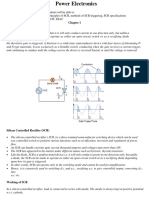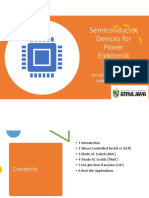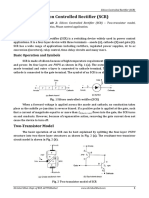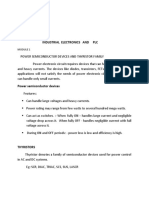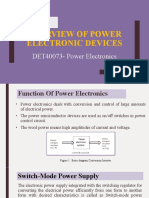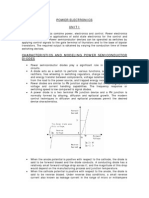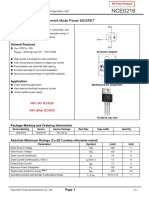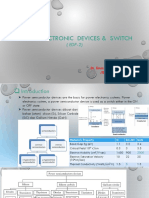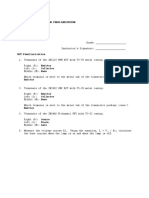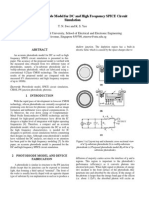Power electronics
It is the application of solid-state electronics to the control and conversion of electric power.
In modern systems, the conversion is performed with semiconductor switching devices such
as diodes, thyristors, and power transistors such as the power MOSFET and IGBT. many
consumer electronic devices, e.g. television sets, personal computers, battery chargers, etc.
The major four types of power electronic circuits are as follows
a) AC to DC converters- Rectifier circuits – converts fixed AC to variable DC (such as half
wave rectifiers or full wave rectifiers)
b) DC to DC converters- chopper circuits – converts fixed DC to variable DC
c) DC to AC converters - Inverter circuits – converts DC to AC having variable amplitude and
variable frequency
d) AC to AC converters - Voltage Regulator circuits – converts fixed AC to variable AC at
same input frequency.
e) Cyclo converters – converts fixed AC to AC with variable frequency
The diagram below shows the block diagram of power electronic system
ANALYSING POWER ELECTRONICS DEVICES
The following are the widely used semicoductor devices in power electronics circuits de
Thyristor
Triac
Diode
Gate turn-off thyristor
The power transistor
Power MOSFET
Insulated gate bipolar transistor
1
�THYRISTORS
A thyristor is a four-layered PNPN semiconductor rectifier in which the flow of current between two
electrodes is triggered by a signal at a third electrode called the gate. The commonly used
thyristor is a silicon controlled rectifier (abbreviated as SCR )
TYPES OF THYRISTORS
There are broadly two types of thyristors namely:
A. Unidirectional thyristors: these are thyristors which conduct in forward direction only,
examples include the;
1. Silicon Controlled Rectifier (SCR),
2. Light Activated Silicon Controlled Rectifier (LASCR),
3. Silicon Controlled switch (SCS)
The graph below shows current – voltage characteristics of unidirectonal thyristors
2
� B. Bidirectional Thyristors
These are thyristors which conduct both in forward and reverse directions. The widely used
bidirectional thyristor is a TRIAC as shown below together with its current - voltage
characteristics
SILICON CONTROLLED RECTIFIER
In a silicon controlled rectifier, load is connected in series with anode. The anode is always kept at
positive potential with respect to cathode. The working of SCR can be studied under the following
two headings:
1. When gate is open. The diagram below shows the SCR circuit with gate open i.e. no voltage
applied to the gate. Under this condition, junction J2 is reverse biased while junctions J1 and J3
are forward biased. Consequently, no current flows through the load RL and the SCR is cut
off. However, if the applied voltage is gradually increased, a stage is reached when reverse
biased junction J2 breaks down. The SCR now conducts heavily and is said to be in the ON
state. The applied voltage at which SCR conducts heavily without gate voltage is called
forward Breakover voltage.
3
�2. When gate voltage is positive with respect to cathode. The SCR can be made to conduct
heavily at smaller applied voltage by applying a small positive potential to the gate as shown in
the diagram below. Now junction J3 is forward biased and junction J2 is reverse biased. The
electrons from n-type material start moving across junction J3 towards left whereas holes from
p-type towards the right. Consequently, the electrons from junction J3 are attracted across
junction J2 and gate current starts flowing. As soon as the gate current flows, anode current
increases. The increased anode current in turn makes more electrons available at junction J2.
This process continues and in an extremely small time, junction J2 breaks down and the SCR
starts conducting heavily. Once SCR starts conducting, the gate (the reason for this name is
obvious) loses all control. Even if gate voltage is removed, the anode current does not
decrease at all. The only way to stop conduction (i.e. bring SCR in off condition) is to reduce
the applied voltage to zero.
Conclusion. The following conclusions are drawn from the working of SCR :
An SCR has two states i.e. either it does not conduct or it conducts heavily. There is no state
inbetween. Therefore, SCR behaves like a switch.
There are two ways to turn on the SCR. The first method is to keep the gate open and make the
supply voltage equal to the breakover voltage. The second method is to operate SCR with supply
voltage less than breakover voltage and then turn it on by means of a small voltage ( typically 1.5
V, 30 mA) applied to the gate.
Applying small positive voltage to the gate is the normal way to close an SCR because the
breakover voltage is usually much greater than supply voltage.
To open the SCR (i.e. to make it non-conducting ), reduce the supply voltage to zero.
4
�ADVANTAGES OF SCR AS A SWITCH.
An SCR has the following advantages over a mechanical or electromechanical switch (relay) :
1. It has no moving parts. Consequently, it gives noiseless operation at high efficiency.
2. The switching speed is very high upto 109 operations per second.
3. It permits control over large current (30–100 A) in the load by means of a small gate current
(a few mA).
4. It has small size and gives trouble free service.
SCR SWITCHING
SCR behaves as a switch i.e. it has only two states these are. ON state and OFF state.
SCR turn-on methods.
In order to turn on the SCR, the gate voltage VG is increased upto a minimum value to initiate
triggering. This minimum value of gate voltage at which SCR is turned ON is called gate triggering
voltage VGT. The resulting gate current is called gate triggering current IGT. Thus to turn on an
SCR all that we have to do is to apply positive gate voltage equal to VGT or pass a gate current
equal to IGT. For most of the SCRs, VGT = 2 to 10 V and IGT = 100 µA to 1500 mA.
D.C. gate trigger circuit. The circuit below shows a typical circuit used for triggering an SCR with
a d.c. gate bias. When the switch is closed, the gate receives sufficient positive voltage (= VGT) to
turn the SCR on. The resistance R1 connected in the circuit provides noise suppression and
improves the turn-on time. The turn-on time primarily depends upon the magnitude of the gate
current. The higher the gate-triggered current, the shorter the turn-on time.
A.C. trigger circuit. An SCR can also be turned on with positive cycle of a.c. gate current.the
diagram below shows such a circuit. During the positive half-cycle of the gate current, at some
5
�point IG= IGT, the device is turned on as shown in the diagram below.
SCR TURN-OFF METHODS.
The SCR turn-off poses more problems than SCR turn-on. It is because once the device is ON,
the gate loses all control. The main two methods of SCR turn-off are discussed below.
natural commutation (Anode current interruption). When the anode current is reduced below
a minimum value called holding current, the SCR turns off. The simple way to turn off the SCR is
to open the line switch S as shown in the circuit on the left below.
Forced commutation. The method of discharging a capacitor in parallel with an SCR to turn off
the SCR is called forced commutation. Fig.(ii)shows the forced commutation of SCR where
capacitor C performs the commutation. Assuming the SCRs are switches with SCR1 ON and
SCR2 OFF, current flows through the load and C as shown in the circuit on the right. When SCR2
is triggered on, C is effectively paralleled across SCR1. The charge on C is then opposite to
SCR1’s forward voltage, SCR1 is thus turned off and the current is transferred to R–SCR2 path.
SCR HALF-WAVE RECTIFIER
One important application of an SCR is the controlled half-wave rectification. t h e d i a g r a m
b e l o w shows the circuit of an SCR half-wave rectifier. The a.c. supply to be rectified is supplied
through the transformer. The load resistance RL is connected in series with the anode. A variable
resistance r is
inserted in the gate circuit to control the gate current.
6
�Operation. The a.c. supply to be converted into d.c. supply is applied to the primary of the
transformer. Suppose the peak reverse voltage appearing across secondary is less than the
reverse breakdown voltage of the SCR. This condition ensures that SCR will not break down
during negative half-cycles of a.c. supply. The circuit action is as follows :
During the negative half-cycles of a.c. voltage appearing across secondary, the SCR does not
conduct regardless of the gate voltage. It is because in this condition, anode is negative w.r.t.
cathode and also PRV is less than the reverse breakdown voltage.
During the positive half-cycles, the SCR will conduct provided proper gate current is made to flow.
The greater the gate current, the lesser the supply voltage at which SCR is turned ON. The gate
current can be changed by the variable resistance r as shown in the diagram above.
it is clear that firing angle is i.e. at this angle in the positive half-cycle, SCR starts conduction. The
conduction angle is (= 180° ).
IMPORTANT PARAMETERS OF SCR HALF-WAVE RECTIFIER








